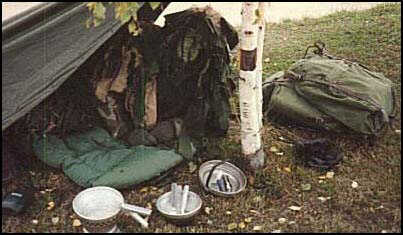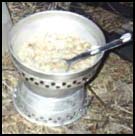
 |
Photo: Private Krüger, Arctic Ranger sniper |
| An Arcitc Ranger's basic
equipment is similar to the basic military items used by
all Swedish infantry soldiers. Some important differences
are the bigger backpack and the extra combat sack. On the
above photo you can see an Arctic Ranger sniper with some
of his basic equipment. He is laying in a so called
"lone wolf" shelter, made from a rain cover
attached to a tree. Next to him is his sleeping bag with
the sleeping mat under. On the grass in front of him is
(from left to right) his small field bottle, a fully
assembled ethanol stove with handle, an extra pot for the
stove (with eating utensils in it), and the lid for the
stove (with a pack of crackers in it). To the right of
the tree is his backpack, which as you can see is almost
empty. A complete description of all the basic equipment carried by each man in the field is listed below. In addition there are certain items that each man does not need to bring, but that you still need in the team, such as axes. This extra equipment is listed at the bottom of this page. |
| Backpack |
|
||
| Combat sack | This is a small 30 litre (1800 cubic inches) sack that you normally store inside (or usually on top of) your main backpack. When you go on combat missions or longer patrols, you bring your combat sack instead of your big backpack. Inside the combat sack you will have the most necessary gear such as rainclothing, food, and warm clothes, as well as things used on your mission like explosives, mines, laser rangefinders etc. | ||
| Combat harness | The standard combat harness of all Swedish forces. Includes pouches for magazines and grenades, and a 0.7 litre field bottle. The field bottle is not used in the winter (the water would freeze). On the harness you also have the standard infantry gas mask. | ||
| Helmet |
 The basic kevlar helmet of all Swedish
forces. The camoflage colored helmet cover is reversible,
and is white on the inside. When it's winter you simply
turn the cover inside-out. The green side of the cover
has a an extra roll-down neck protecor, that is used in a
chemical environment. The basic kevlar helmet of all Swedish
forces. The camoflage colored helmet cover is reversible,
and is white on the inside. When it's winter you simply
turn the cover inside-out. The green side of the cover
has a an extra roll-down neck protecor, that is used in a
chemical environment. |
||
| Entrenching tool | The basic foldable infantry shovel, made of steel. In the winter you attach an aluminum blade to the shovel so you can dig snow faster and be able to make blocks from the snow. | ||
| Knife | A Swedish made Mora knife, with a plastic handle. It is used for all kinds of cutting, but is not very usefull for heavier work such as chopping, or as a combat knife. Therefore many men use their own knifes, usually larger knifes (Gerber, Cold Steel and other brands) as well as smaller tool-knifes such as Leatherman. | ||
| Flashlight | This is a standard army green flashlight. It has two filters, a red and a blue. You almost always use the red filter, to avoid detection. It has a strap with two holes in, so you can attach it to the buttons on the front of your snowsuit, which enables you to work with both hands. The flashlight is essential in an environment when the sun never rises above the horizon for large portions of the winter. | ||
| Sleeping bag | A heavy (and warm!) sleeping bag containing down. In the winter you have an extra outer sleeping bag, containing synthetic filling. With double sleeping bags you can comfortably sleep in a non-heated tent or a makeshift shelter at -35° C (= -30° F). | ||
| Sleeping mat (with rain cover) |
The sleeping mat is a foldable foam mat that you sleep on to insulate your body from the cold ground. To put it on your backpack, you fold it inside a rain cover and strap it between the lid and the sack on your backpack. The rain cover is used for making various shelters. You can use it as a 1-man rain shelter by attaching it to a tree (see top of page for a photo of this). Read more about this raincover in the "Tents" section. | ||
| Thermos | A 1 litre stainless steel thermos. You fill it with hot water and add a powdered soup, which you drink during a break. It is a good idea to cover your thermos with tape, so it easier to screw off the top with your mitts on (it's very slippery otherwise). In the summer you usually use an ordinary 1.5 litre platic bottle instead of the thermos. | ||
| Ethanol stove |
 This is like a civilian 1-man storm stove.
It is all made of aluminium, and consists of a base (that
protects the burner from the wind), two pots (1 and 0.7
litres), a handle (to lift the pots) and a Trangia
ethanol burner. All the parts can be placed inside the
large pot for easy storage. In addition to the stove you
have a plastic bottle with fuel. Since ethanol isn't a
very effecient fuel you don't use this stove in the
winter. Instead you use a 3-man kerosene stove (see
below). This is like a civilian 1-man storm stove.
It is all made of aluminium, and consists of a base (that
protects the burner from the wind), two pots (1 and 0.7
litres), a handle (to lift the pots) and a Trangia
ethanol burner. All the parts can be placed inside the
large pot for easy storage. In addition to the stove you
have a plastic bottle with fuel. Since ethanol isn't a
very effecient fuel you don't use this stove in the
winter. Instead you use a 3-man kerosene stove (see
below). |
||
| Cup/utensils | Consists of a 0.4 litre plastic cup and a utensil set with fork, knife and spoon. Since all the food is dehydrated powder, you leave the knife and fork at the barracks and only bring the spoon. | ||
| Hygien | This consists of the necessary hygien items used in the field, such as toothbrush and tooth cream, soap, shaving equipment and a towel. In the winter you usually don't bring shaving equipment, because your face freezes very easily if it's shaved. |
| In addition to the above listed equipment, a ranger team will bring some of the bellow listed equipment. Ranger teams are made up of 2-4 (usually 3) groups, each with 3 men, making a team either 6, 9 or 12 men. A 3-man group should be self-sufficient, and therefore all groups in a team have identical equipment. |
| Binoculars: | The standard 6X zoom binoculars. It is used for spotting during sniping, searching for the enemy when on an ambush, and can be usefull when navigating in mountain terrain. In the winter you usually tape it with white tape for better camoflage. You generally have one binoculars per 3 men. |
| Axe | A small axe, with steel axehead and wooden handle. Used to chop down trees and hammer tentpoles into the ground. This is especially usefull in the winter when the ground is rock-hard. You also use it to split firewood, which you use in the wood-fired stove at the main base (read more about this in the "Tents" section). You have one axe per 3 men. |
| Ranger saw | A collapsable saw with an extra sawblade in the handle. Used to saw down trees and saw snowblocks. You have one saw per 3 men. |
| Kerosene stove | A 3-man kerosene stove, used mainly in the winter. The stove consists of a pressure tank with a hand operated plunger pump (to raise the pressure), a burner (with built-in cleaning needle) and two pots (each about 2 litres). Since kerosene isn't very flamable you need to pre-heat the stove with ordinary ethanol. Once you get the stove running, the effect is very high, about 3000 watts. As you might guess, you have one kerosene stove per 3 men. |
| Snowshovel | This is a large, white painted snowshovel. You usually have this only at the main base, since this is the place that you will be doing the most digging, such as digging out for a tent and ATV. |
Back to Equipment